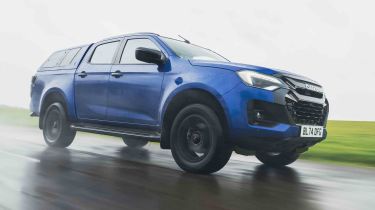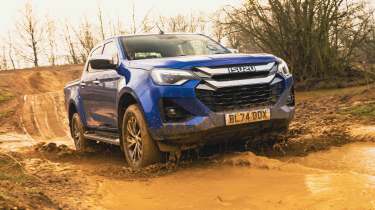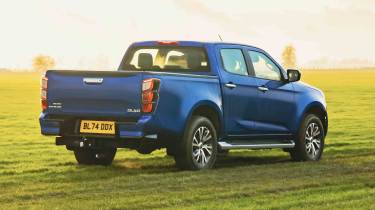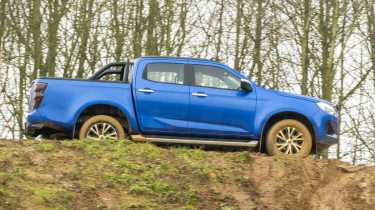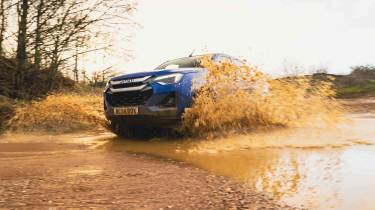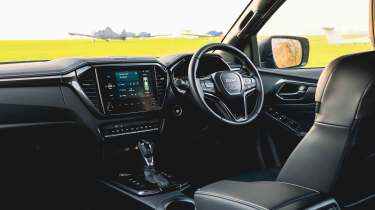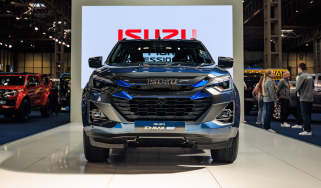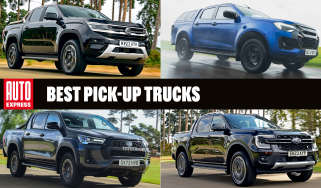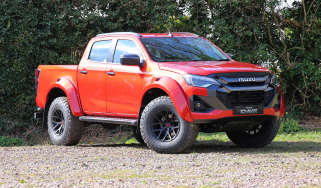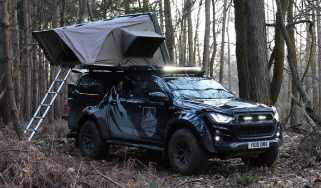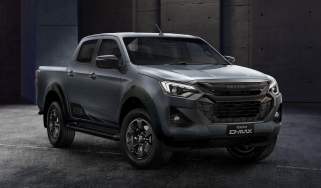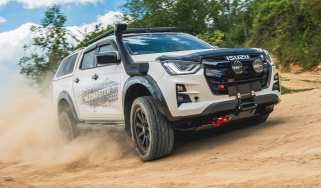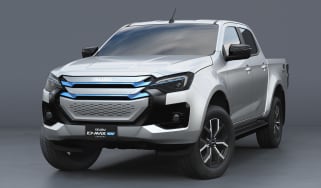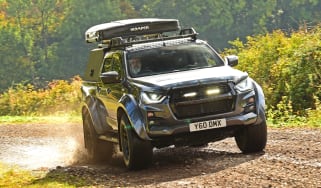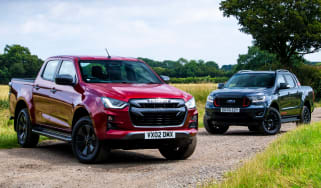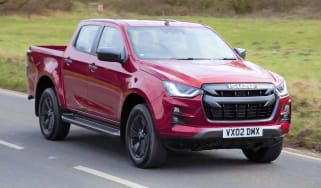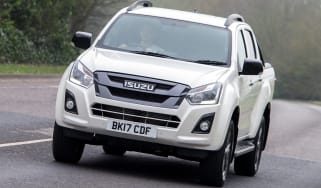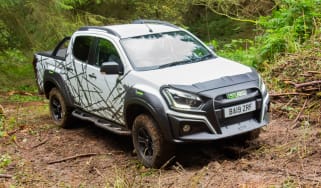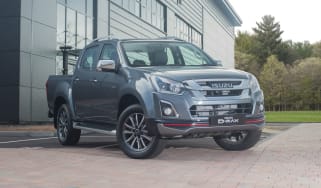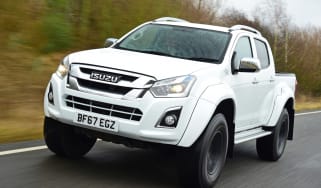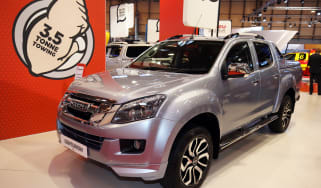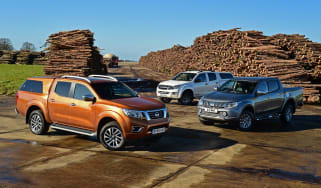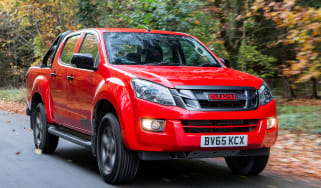Isuzu D-Max review
Constant updates help the Isuzu D-Max to keep pace with the pick-up truck pack
A long warranty and generous levels of standard kit make the Isuzu D-Max an appealing proposition, and there’s a range of models on offer to suit different purposes. The Utility variant is a workhorse through and through, while at the top of the range, the V-Cross makes a strong case for itself as a work vehicle that also offers family car versatility. Constant revisions have helped the D-Max keep pace with rivals, and its off-road ability is good, but the solitary 1.9-litre diesel on offer lacks power when compared with the class leaders. It’s not quite as well mannered as its rivals on the road, either.
The most recent round of updates in 2025 added a subtly revised front end with new air intakes that help airflow around the front wheels, a tweaked bonnet line and new lights. At the back are new tail-lights and a redesigned tailgate, while inside there’s a more user-friendly infotainment system measuring eight inches across (or nine inches in the V-Cross). The twin-camera ADAS system has been upgraded with wider viewing angles to improve the response of the safety systems, while a Rough Terrain switch optimises the truck’s electronics for slippery conditions.
| Key specs | |
| Fuel type | Diesel |
| Body style | Two-door single cab pick-up truck Two-door extended cab pick-up truck Four-door double cab pick-up truck |
| Powertrain | 1.9-litre diesel, selectable four-wheel drive |
| Safety | Five stars Euro NCAP (2022) |
| Warranty | Five years/125,000 miles |
About the Isuzu D-Max
A broad range of models kicks off with the Single Cab Isuzu D-Max Utility starting from around £27,500 excluding VAT. This is two-wheel drive as standard, with an extra £2,500 adding four-wheel drive and a diff lock. The Extended Cab Utility is around £31,000, while upgrading to the Double Cab is less than £1,000 extra.
Used - available now

2023 Jaguar
I-PACE
40,850 milesAutomaticElectric
Cash £22,000
2022 Kia
Stonic
63,869 milesAutomaticPetrol1.0L
Cash £13,000
2023 Land Rover
Discovery Sport
30,899 milesAutomaticPetrol1.5L
Cash £26,000
2021 Volkswagen
Polo GTI
54,000 milesAutomaticPetrol2.0L
Cash £16,000The DL20 is available as either an Extended Cab or Double Cab for around £34,000 ex.VAT, while an auto gearbox is offered on the latter for roughly £2,000 extra. Add around £3,000 to move from DL20 to DL40 trim (as a Double Cab only), while the V-Cross starts at £38,000, with the auto version adding £2,000. The high-riding Arctic Trucks variant will return to the line-up later, but is expected to carry a hefty premium over the V-Cross.
Whichever model you choose, the same 162bhp four-cylinder turbodiesel is fitted under the bonnet, while six-speed manual or automatic transmissions are fitted.
Isuzu D-Max history
Japanese firm Isuzu has been around since 1917, and has produced low volumes of cars over the years, including the sporty 117 Coupe, Bellet and Piazza/Impulse, the Trooper and VehiCross 4x4s and a number of pick-up trucks. It also has a truck and commercial vehicle division that makes small cabover trucks and buses.
The D-Max first arrived in 2012 with a 3.0-litre diesel and was pitched to tradespeople and farmers as a workhorse. A smaller, more efficient, but just as powerful 1.9-litre diesel arrived in 2017, while the current D-Max arrived in 2021. There have been updates in 2023 and 2025, while an all-electric D-Max is due to arrive in 2026.
MPG, emissions & running costs
The 1.9-litre turbodiesel has a lack of torque when compared with rivals, so it needs to be given a workout if you’re going to be using the D-Max to carry heavy loads or for towing. Stop-start is included to help save diesel when stationary, but overall efficiency isn’t quite a match for rivals.
With the six-speed manual gearbox, the entry-level D-Max Single Cab with 2WD returns 33.6mpg, with CO2 emissions of 220g/km, while adding four-wheel drive has a slight impact on those figures. Move up to a high-spec model with an automatic gearbox and that drops to 31.4mpg and 235g/km of CO2. That’s fine for now, but when double cab pick-ups qualify for emissions-based Benefit-in-Kind company car tax from April 2025, the bills will rise sharply over the current flat rate of commercial vehicle BiK.
In order for Isuzu to be able to meet tightening emissions regulations, the D-Max now comes with an AdBlue tank. It’s 14 litres in capacity and the filler is next to the one for the fuel tank, while the car’s on-board trip computer will count down to when it needs topping up.
| Model | MPG | CO2 | Insurance group |
| D-Max 1.9D Single Cab 2WD | 33.6mpg | 220g/km | 50 |
| D-Max 1.9D Single Cab 4WD | 33.2mpg | 223g/km | 50 |
| D-Max 1.9D Double Cab 4WD | 32.5mpg | 227g/km | 50 |
| D-Max 1.9D Double Cab 4WD auto | 31.4mpg | 235g/km | 50 |
Load space and practicality
| Dimensions | |
| Length | 5,280mm |
| Width | 1,810mm |
| Height | 1,790mm |
| Number of seats | Five (double cab) |
| Bed dimensions (LxWxD) | 1,520x1,530x500mm |
The availability of Single Cab and Extended Cab bodies gives the D-Max an advantage over pick-up truck rivals, especially because these variants won’t be subject to the BiK change coming in April 2025 – they will still qualify as commercial vehicles after that date. The main caveat with the Single Cab model is that it sits 20mm lower to the ground than the Extended and Double Cab variants, so isn’t geared towards extreme off-road use.
The Single Cab has a 2,290mm long load bay and a maximum payload of 1,205kg in 4WD guise (the 2WD version can carry 1,190kg). Next is the Extended Cab, which has a 1,785mm load bay and a 1,140kg payload capacity, and then the Double Cab has a bed that measures 1,520mm long and a payload of up to 1,110kg, depending on trim level. All versions can carry more than a tonne in the back, though.
If you want to tow, then the D-Max offers 3.5 tonnes of capacity (except for the Single Cab 2WD, which can still pull a healthy 2.5 tonnes). There are plenty of accessories to choose from to help with towing and cargo carrying in general, including load covers and hard-top backs in various styles. Plus there are roof bars, frames and cargo rails to hold loads in place in the bed.
There are simply too many accessories to list here, but it’s safe to say that if you have a specific need for a D-Max, there is likely to be something in the catalogue that can help you.
Safety & reliability
| Key standard safety features | Euro NCAP safety ratings |
|
|
Safety is a real strong point for the D-Max. It’s the only truck on sale that has a five-star Euro NCAP safety rating, while the 2025 update has uprated the safety systems, so it would likely still earn a five-star rating if it was retested today. The twin forward cameras have a wider field of view and can detect pedestrians, cyclists and motorcycles, while traffic sign recognition can detect speed limits, stop and give way signs and more. Other kit includes lane-departure warning, attention assist, rear cross-traffic alert and a blind-spot monitor (Double Cab only).
Isuzu sells too few models to appear on our annual Driver Power customer satisfaction surveys, so it’s tough to get feedback from owners – but the D-Max has an enviable reputation for reliability. The brand offers a five-year/125,000-mile warranty on all models.
Engines, performance & drive
The only engine option in the D-Max is a 162bhp 1.9-litre four-cylinder turbodiesel, but it can be had with a six-speed manual or automatic gearbox. We prefer the latter, because the vague shift action of the manual isn’t very pleasant to use.
There’s a very short first gear, which is helpful when towing, but a bit of a frustration at other times, because you have to change up as soon as you pull away – it’s entirely possible to treat second gear as first if you’re unladen. The auto manages gearshifts better and is smooth overall, but it can be a bit slow to react when pulling out at junctions.
The engine itself is reasonably strong thanks to a torque figure of 360Nm, but rivals offer more pulling power. The engine is quite noisy, too, and since it delivers its power higher in the rev range than some other diesels, you end up having to push it harder than normal – which means you notice the rattly sound and vibrations more, too.
The gearbox has an “on-the-fly” 4WD switch, so you don’t need to stop before swapping from two to four-wheel drive, although you do have to come to a halt and put the gearbox into neutral to use the same rotary controller to select low-range gears. The rear diff lock is different, as this only engages in low-range mode at speeds below 5mph, while the latest update added a Rough Terrain mode that’s selected via a button on the dashboard. This optimises the electronics to cope with off-road conditions, and can even be used when in 2WD mode.
As a result of all these mechanical and electronic systems, the D-Max is an impressive performer off-road. We tried the truck on an off-road course consisting of wet, slippery clay, and even with the limitations of cross-climate tyres (Isuzu will offer all-terrain tyres as an accessory) we struggled to get stuck. The electronic systems work smoothly, while the steering, throttle and brakes boosted confidence when traction was at a premium.
On the road, the D-Max is a step behind the class leaders in terms of comfort. The latest updates haven’t changed the powertrain, and that means that while the higher-spec variants are the most comfortable in the line-up, there’s more bounce and noise than you’ll find in a Ford Ranger or Volkswagen Amarok. The D-Max’s safety systems work well, though, and aren’t too intrusive.
Cab and interior
New for 2025 is a revised infotainment screen measuring eight inches across the range, although the V-Cross has a larger nine-inch display. This is better laid out than before – where DAB radio and AM/FM were separate on the old system, they are all in the same place now. It has Android Auto and Apple CarPlay compatibility – which is handy because sat-nav isn’t included – while there’s a range of screens that can show you the D-Max’s off-road performance, including pitch, yaw and steering angles.
Standard kit ranges from practical to SUV-like, depending on the model you choose. The Utility does what it says on the tin, with a functional cab full of hard plastics and durable fabrics, although the eight-inch touchscreen is included, so there’s Bluetooth smartphone connectivity.
The DL20 adds kit such as heated seats and a leather trimmed steering wheel, alloy wheels and carpets, and moving to the DL40 adds LED headlights, front and rear parking sensors, leather, keyless entry and starting, dual-zone climate control and a seven-inch digital dashboard. The V-Cross has the larger touchscreen, heated door mirrors, an eight-speaker stereo, extra USB-C ports and dark grey exterior trim.
Storage is good on all double-cab models: there are two gloveboxes, plus a storage cubby on top of the dash and pop-out cup-holders. There’s a central cubby under the armrest and more cup-holders in the centre console.
Isuzu D-Max alternatives
While there are fewer models available in the pick-up truck class, there is variety within the trucks that are still for sale. The big seller in the class is the Ford Ranger, which comes in a wide range of styles from utilitarian to luxury and performance, while V6 power is available. The Volkswagen Amarok is related to the Ranger, and offers a plush experience in comparison.
Elsewhere, the Toyota Hilux is a perennial favourite that offers dependability, while the KGM (formerly SsangYong) Musso has a strong warranty to make up for its limited line-up and smaller cargo bed. If efficiency is key, then the Maxus T90 electric pick-up is on offer, but this is 2WD only, so it won’t get very far off road.
From April, when double cab pick-ups pay Benefit-in-Kind rates based on CO2, then you might want to consider the Ineos Grenadier Quartermaster – it doesn’t have a one-tonne payload, but will be great for towing.
Frequently Asked Questions
There’s a long five-year warranty with a mileage limit of 125,000 miles that should cover most work needs. On top of that, the D-Max comes with five years of UK and European roadside assistance.

